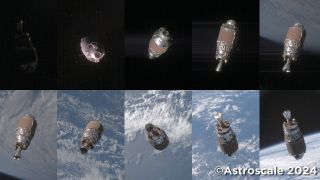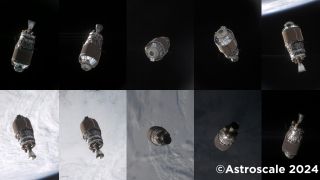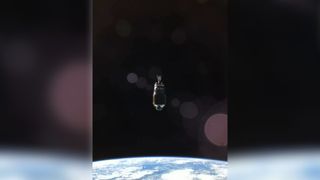Space-junk scout captures amazing fly-around footage of discarded rocket in orbit (video)
Good news! Astroscale's orbital inspector spacecraft finds no damage on 15-year-old rocket junk.
Astroscale's ADRAS-J orbital inspection mission has taken all-around close ups of its target piece of space debris. The stunning footage of the 36-foot-long (11 meters) rocket stage was taken from mere 164 feet (50 m) and revealed no substantial damage to the object. That means the rocket debris is a go for a ground-breaking removal attempt that Astroscale plans to undertake later this decade.
Astroscale's ADRAS-J (short for Active Debris Removal by Astroscale-Japan) spacecraft has been examining the 15-year-old piece of space debris since February. The Tokyo-headquartered company has previously released a series of photographs revealing the 3-ton rocket stage suspended in microgravity above Earth. The new footage, released on Tuesday, July 30, captures the object from various angles while illuminated with sunlight of varying intensity.
The images used for the videos were captured on July 15 and 16 during two fly-around imaging runs that marked a key milestone in the mission.

"Astroscale has achieved an unprecedented technical milestone for a commercial company: the controlled fly-around operations of the space debris — a rocket upper stage — capturing images from various angles and lighting conditions while maintaining a controlled fixed-point relative position of approximately 50 meters from the upper stage," the company said in a statement. "ADRAS-J is the world's first attempt to safely approach, characterize and survey the state of an existing piece of large debris through Rendezvous and Proximity Operations."
Space debris is a growing problem. According to the European Space Agency, some 40,500 space debris objects greater than 4 inches (10 centimeters) currently hurtle through Earth's orbits together with millions of smaller fragments.
Travelling at speeds of several miles per second, these dead objects pose a risk to operational satellites as well as to the International Space Station. The world's space agencies are therefore trying to devise solutions to remove the most worrying space debris pieces from orbit.

Astroscale has previously demonstrated its systems designed to autonomously approach and capture uncontrollable debris objects with its ELSA-d (End-of-Life Services by Astroscale demonstration) mission in 2021.
Get the Space.com Newsletter
Breaking space news, the latest updates on rocket launches, skywatching events and more!
In April, the Japanese Aerospace Exploration Agency (JAXA), which funds ADRAS-J, selected Astroscale for a follow-on mission, which will attempt to remove the old rocket stage from orbit using a robotic arm.
These new images gathered by ADRAS-J will help Astroscale prepare for the ground-breaking task, which could help restore order in the cluttered orbits in the future.
"Development of the ADRAS-J2 spacecraft is underway, and the heritage of the ADRAS-J spacecraft and operations, along with the data collected, will be utilized for the removal phase of the program," Astroscale said in the statement.
The recent fly-arounds confirmed that the rocket's payload adapter, which the ADRAS-J2 robotic arm is expected to grab, is intact, meaning the mission can continue as planned.
"Unprepared objects in orbit are not designed with any technologies that enable docking or potential servicing or removal, heightening the complexity of operations," Astroscale said in the statement. "The information gained from these images will provide essential data that will support a future mission to capture and remove the object."

The ADRAS-J2 mission will be one of the world's first attempts to remove a large piece of debris from orbit. ADRAS-J2 is expected to launch in 2027.
On July 11, Astroscale signed a contract with OneWeb to remove one of its satellites fitted with a magnetic docking plate from orbit in 2027. The company is also vying for a U.K. Space Agency contract to remove two defunct British satellites launched in the 1990s. That mission, called COSMIC, also intends to use a robotic arm.
The European Space Agency, in cooperation with Swiss company ClearSpace, is developing another mission known as ClearSpace-1 that could attempt to deorbit a smaller rocket part in 2026.
Join our Space Forums to keep talking space on the latest missions, night sky and more! And if you have a news tip, correction or comment, let us know at: community@space.com.

Tereza is a London-based science and technology journalist, aspiring fiction writer and amateur gymnast. Originally from Prague, the Czech Republic, she spent the first seven years of her career working as a reporter, script-writer and presenter for various TV programmes of the Czech Public Service Television. She later took a career break to pursue further education and added a Master's in Science from the International Space University, France, to her Bachelor's in Journalism and Master's in Cultural Anthropology from Prague's Charles University. She worked as a reporter at the Engineering and Technology magazine, freelanced for a range of publications including Live Science, Space.com, Professional Engineering, Via Satellite and Space News and served as a maternity cover science editor at the European Space Agency.
-
barnaclefligby actually, this amounts to a public advertisement directed at national intelligence and defense agencies showcasing their commercial "turn key" anti-satellite defense and surveillance technology.Reply -
PHS Why is it that pictures of UFOs never have this type of clarity? Photos of UFOs are always grainy and blurry, or fuzzy blobs of light. If a picture of a UFO showed this much detail, I would be a believer.Reply -
RAA As far as I have ever seen or read, no purported sightings of UFOs ( UAPs) have ever been within a slow orbit just 50 meters from the phenomena. As a minimum, the sighting must be closely tracked with a high quality tracking device, while moving often very rapidly and/or erratically.Reply
Or perhaps most UAPs just don't want to be closely observed ...